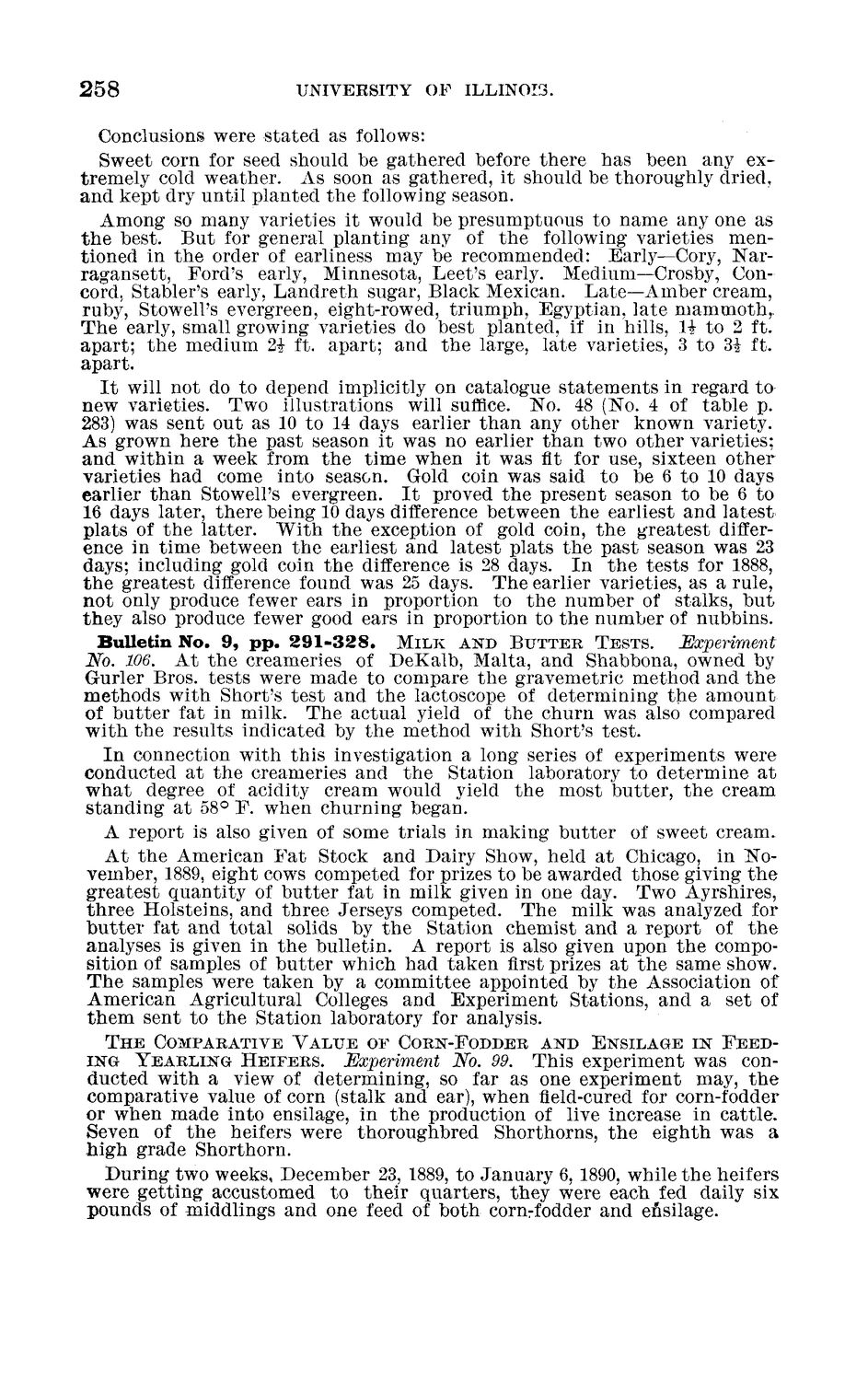| |
| |
Caption: Board of Trustees Minutes - 1890
This is a reduced-resolution page image for fast online browsing.

EXTRACTED TEXT FROM PAGE:
258 UNIVERSITY OF ILLINOIS. Conclusions were stated as follows: Sweet corn for seed should he gathered before there has been any extremely cold weather. As soon as gathered, it should be thoroughly dried, and kept dry until planted the following season. Among so many varieties it would be presumptuous to name any one as the best. But for general planting any of the following varieties mentioned in the order of earliness may be recommended: Early—Cory, Narragansett, Ford's early, Minnesota, Leet's early. Medium—Crosby, Concord. Stabler's early, Landreth sugar, Black Mexican. Late—Amber cream, ruby, Stowell's evergreen, eight-rowed, triumph, Egyptian, late mammoth,. The early, small growing varieties do best planted, if in hills, H to 2 ft. apart; the medium 21 ft. apart; and the large, late varieties, 3 to 3£ ft. apart. I t will not do to depend implicitly on catalogue statements in regard to new varieties. Two illustrations will suffice. No. 48 (No. 4 of table p. 283) was sent out as 10 to 14 days earlier than any other known variety. As grown here the past season it was no earlier than two other varieties; and within a week from the time when it was fit for use, sixteen other varieties had come into season. Gold coin was said to be 6 to 10 days earlier than Stowell's evergreen. I t proved the present season to be 6 to 16 days later, there being 10 days difference between the earliest and latest plats of the latter. With the exception of gold coin, t h e greatest difference in time between the earliest and latest plats the past season was 23 days; including gold coin the difference is 28 days. In t h e tests for 1888, the greatest difference found was 25 days. The earlier varieties, as a rule, not only produce fewer ears in proportion to the number of stalks, b u t they also produce fewer good ears in proportion to the number of nubbins. Bulletin No. 9, pp. 2 9 1 - 3 2 8 . M I L K AND B U T T E R TESTS. Experiment No. 106. A t t h e creameries of DeKalb, Malta, and Shabbona, owned by Gurler Bros, tests were made to compare the gravemetric method and t h e methods with Short's test and the lactoscope of determining the amount of butter fat in milk. The actual yield of the churn was also compared with the results indicated by the method with Short's test. I n connection with this investigation a long series of experiments were conducted at the creameries and t h e Station laboratory to determine a t what degree of acidity cream would yield the most butter, t h e cream standing at 58° F . when churning began. A report is also given of some trials in making butter of sweet cream. At the American F a t Stock and Dairy Show, held a t Chicago, in November, 1889, eight cows competed for prizes to be awarded those giving t h e greatest quantity of butter fat in milk given in one day. Two Ayrshires, three Holsteins, and three Jerseys competed. The milk was analyzed for butter fat and total solids by t h e Station chemist and a report of t h e analyses is given in the bulletin. A report is also given upon t h e composition of samples of butter which had taken first prizes at t h e same show. The samples were taken by a committee appointed by the Association of American Agricultural Colleges and Experiment Stations, and a set of them sent to the Station laboratory for analysis. T H E COMPARATIVE YALTJE OF CORN-FODDER AND E N S I L A G E I N F E E D - ING YEARLING H E I F E R S . Experiment No. 99. This experiment was conducted with a view of determining, so far as one experiment may, t h e comparative value of corn (stalk and ear), when field-cured for corn-fodder or when made into ensilage, in t h e production of live increase in cattle. Seven of t h e heifers were thoroughbred Shorthorns, the eighth was a high grade Shorthorn. During two weeks, December 23, 1889, to January 6, 1890, while t h e heifers were getting accustomed to their quarters, they were each fed daily six pounds of middlings and one feed of both corn r fodder and ensilage.
| |